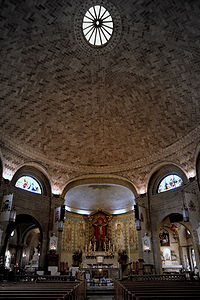Basilica of St. Lawrence, Asheville
The Minor Basilica of St. Lawrence the Deacon & Martyr is a minor basilica of the Roman Catholic Church in downtown Asheville, North Carolina, United States. The church was designed and built in 1905 by Spanish architect Rafael Guastavino along with his fellow architect R. S. Smith and the Roman Catholic community of Asheville.[1] Pope John Paul II elevated the status of the church to minor basilica in 1993. It is a parish church, located within the Diocese of Charlotte. It is on the National Register of Historic Places. It is the only basilica in western North Carolina. Its dome has a span of 58 by 82 feet (18 by 25 m) and is reputed to be the largest, freestanding, elliptical dome in North America.[2] Except for the foundation and brick walls, the architectural style is Catalan, with the main example being the stairs behind the altar.[3] It is located in the Downtown Asheville Historic District.
| The Minor Basilica of Saint Lawrence | |
|---|---|
 Principal Facade, Basilica of St. Lawrence | |
| Religion | |
| Affiliation | Roman Catholic Church |
| District | Roman Catholic Diocese of Charlotte |
| Rite | Latin Rite |
| Leadership | Very Rev. Wilbur N. Thomas V.F., Rector |
| Status | Minor Basilica |
| Location | |
| Location | Asheville, North Carolina, United States |
| State | North Carolina |
| Architecture | |
| Architect(s) | Rafael Guastavino |
| Style | Spanish Baroque |
| Completed | 1905 |
| Website | |
| www | |
Interior
The inside of the basilica is adorned with statues of saints, including St. Lawrence, St. Cecilia, St. Rose of Lima, St. Patrick, and St. Peter the Apostle. The Daprato Statue Company made the statues in Italy. The high altar is made from Tennessee marble. Above the high altar in the sanctuary is a Spanish wood carving of the Virgin Mary and John the Apostle mourning at the crucifixion of Christ. Behind the wood carving of the crucifixion and covering the entire wall of the apse are polychrome, terra cotta, ornamental partitions of the Four Evangelists and Archangels St. Raphael and St. Michael.
Stained glass windows
The basilica is known for its many elaborate stained glass windows, many of which were made in Munich, Germany. On the right wall of the basilica, the windows depict the Annunciation of the Blessed Virgin Mary, the Visitation of the Blessed Virgin Mary, the Nativity of Christ, the Child Christ Teaching in the Temple, and the Conversion of Saint Paul. On the left wall the windows depict the Wedding at Cana, Christ Healing the Daughter of Jairus, the Calming of the Wind and Waves, the Agony in the Garden, and the Resurrected Christ appearing to St. Mary Magdalene. The two large windows, one on the eastern wall and one on the western wall, represent Christ healing the afflicted and the Transfiguration of Christ. The large window in the organ loft portrays the Resurrection of Christ.
- Christ Healing the Afflicted
- The Transfiguration of Christ
Chapels
To the right and the left of the high altar are two chapels.
Chapel of Our Lady
The first chapel, to the left of the altar, is a lady chapel named "Chapel of Our Lady" that contains a Marian altar made of marble, with a statue of the Immaculate Conception adorned by two angels. On the front of the Marian altar are carvings of St. Margaret, St. Lucia, St. Cecilia, St. Catherine of Alexandria, St. Barbara, St. Agnes, St. Agatha, and St. Rose of Lima. Forming a frame around the altar are a series of tiles with the names of the Blessed Virgin Mary selected from the Litany of the Blessed Virgin and in the center is a fragment of an Italian marble depicting the Nativity of Christ. Above the Marian altar are seven doves that represent the Seven Gifts of the Holy Spirit. The icons of the Blessed Virgin Mary in the chapel depict the Virgin Mary as Our Lady of Czestochowa, Our Lady of Perpetual Help, Our Lady of Guadalupe, and Our Lady of the Annunciation, with votive candles under each icon. The two stained glass windows in the chapel are of Our Lady, Star of the Sea and Saint Raphael the Archangel. In the back left of the chapel is the crypt of Rafael Guastavino.[2]
- Marian altar
- Italian marble relief of the Nativity of Christ
Eucharistic Adoration Chapel
The second chapel, to the right of the main altar, is the "Eucharistic Adoration Chapel", originally named the "Chapel of St. Joseph". The chapel is used for Eucharistic adoration and private prayer.[2] The Holy Eucharist is displayed on the chapel's altar before and after Mass for adoration, prayer, and meditation. The stained glass window above the altar depicts the Nativity of Christ, similar to the tile painting in the Marian chapel. The eastern wall's window is a stained glass painting depicting the death of St. Joseph in the arms of his family: Jesus Christ and the Blessed Virgin Mary. The smaller window in the chapel depicts St. Lawrence, to whom the basilica is dedicated. The chapel's altar and part of the apse wall are a mosaic of bits of tile assembled by Rev. Peter Marion and Rev. Patrick Marion, who were priests during the construction of the basilica.
Grounds
The basilica includes a rectory for the priest, a Catholic library, and a gift shop for tourists, which are open after weekend Masses.[4][5] Behind the basilica is a Mary garden, which contains a life sized, white statue of the Blessed Virgin Mary.
Gallery
 Rear of the Basilica[6]
Rear of the Basilica[6] Dome of the Basilica[7]
Dome of the Basilica[7] Altar of the Basilica[8]
Altar of the Basilica[8] Inside the structure of the dome is the tomb of Rafael Guastavino
Inside the structure of the dome is the tomb of Rafael Guastavino
References
- "Archived copy". Archived from the original on 2011-07-14. Retrieved 2010-07-21.CS1 maint: archived copy as title (link)
- "Archived copy". Archived from the original on 2009-12-27. Retrieved 2010-07-21.CS1 maint: archived copy as title (link)
- Neufeld, Rob (2017-04-10). "Visiting Our Past: Local architect Guastavino recalled". Asheville Citizen-Times. Retrieved 2017-04-10.
- "Archived copy". Archived from the original on 2011-07-27. Retrieved 2010-09-18.CS1 maint: archived copy as title (link)
- "basilicalibrary's books | LibraryThing". www.librarything.com. Retrieved Dec 14, 2019.
- "Archived copy". Archived from the original on 2007-10-08. Retrieved 2007-01-04.CS1 maint: archived copy as title (link)
- "Archived copy". Archived from the original on 2007-10-11. Retrieved 2007-01-04.CS1 maint: archived copy as title (link)
- "Archived copy". Archived from the original on 2007-10-11. Retrieved 2007-01-04.CS1 maint: archived copy as title (link)
External links

- St. Lawrence's official website


